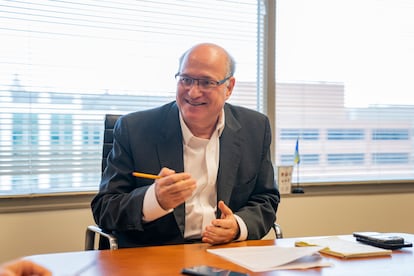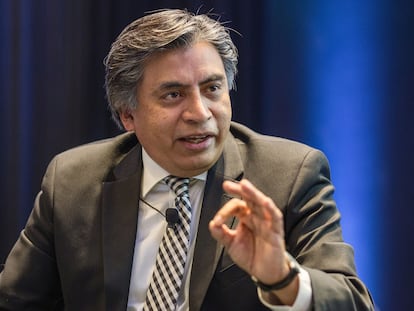Ilan Goldfajn, new president of IADB: ‘My tenure will be one of dialogue, bridge-building and coalitions’
Ilan Goldfajn – the former head of the Central Bank of Brazil – takes over the IDB at a time when the financial institution’s role is even more important given rising inflation and interest rates


Two photographs of Pelé hang on the wall of the office of the new president of the Inter-American Development Bank (IADB). Ilan Goldfajn – a 56-year-old Brazilian economist – is passionate about soccer. He tells EL PAÍS that the sport has taught him many lessons in life, although he doesn’t play anymore. “Too risky,” he jokes. He recalls the 1982 World Cup. At the age of 16, he watched Brazil lose to Italy. “Brazil had a great team, they were going to win the World Cup, but we lost. I learned that you’re not going to always win and you’re going to be disappointed. But you have to continue.”
Goldfajn won the vote to head the IADB by a landslide, after his American predecessor – Mauricio Claver-Carone – was dismissed last September. The new boss – who hails from Latin America, where all the borrowing member countries of the IADB are based – claims to be very excited about the job.
“This is a great opportunity. We’re going to have an open, transparent administration without conflict. There won’t be a culture of fear, it won’t be a problem if people have different opinions. Everyone perceives that my tenure at the IADB will be one of dialogue, bridge-building and coalitions,” he assures EL PAÍS.
The new president, who holds a doctorate in economics from MIT, has not yet announced his team, but he is clear about his vision and priorities. He wants the IADB to be the most important multilateral development bank in the region, and for member countries to see it as an essential ally – not only for loans, but also for giving advice, sharing knowledge and providing solutions.
“My election gave us a mandate to work together for what matters: the hundreds of millions of people in the region.” In terms of priorities, the first are social issues, such as the fight against poverty or inequality. “Inequality is not only about income – it also has to do with gender, race and various other inequalities that people no longer accept,” he explains. Goldfajn also wants to tackle food insecurity – aggravated by the pandemic and inflation – and climate change.
“We have to work on decarbonization in a responsible way, both in mitigation and adaptation in Latin America. We have countries that are already experiencing hurricanes and other phenomena with greater frequency. The climate problem for Latin America and the Caribbean is not only the future: it’s already the present.”
Another priority is bolstering investment in digital and physical infrastructure. He also wants to promote projects that benefit more than one country. “An international organization has to lead the way,” he shrugs. “The focus cannot be the amount of resources we lend, but whether that amount has the effect we want.”
He believes that the bank’s priorities fit with those of the governments in power throughout Latin America and the Caribbean. The entire region has taken a political turn to the left in recent years. “Our focus is on fighting poverty and inequality. I don’t think the rulers have another agenda.” When asked about the criticism surrounding Mexican President López Obrador – who wants to change his country’s laws to seek a second term – or about the influence of China (a member country) in the IDP, Goldfajn is cautious in his response.
“When you look at [collaboration] programmatically, technically, I don’t see any problem. Operationally, there is a good relationship. There is communication, there are projects in which we are aligned. We have to leave ideology at the door and focus on people.”
“All partners have the same goal of having a large, active BID that can improve the lives of the millions of citizens in the region,” he adds.
Regarding the global rise in interest rates, he emphasizes that “the role of the IADB will become even more important in the coming years, because when credit becomes more expensive or scarce, the role of public financing becomes essential.”
Goldfajn comes to the IADB from the International Monetary Fund (IMF), where, since September 2021, he directed the Western Hemisphere Department. He was governor of the Central Bank of Brazil from 2016 and 2019, with great success. His candidacy for the IADB was presented when Brazil’s Jair Bolsonaro was still in power, but was ratified by the current incumbent, Luiz Inácio Lula da Silva. He is a respected technocrat on both sides of the aisle.
The economist – who has just settled down in Washington, D.C., where he lived briefly in the 1990s – strongly condemns the assault on the institutions of Brasília last Sunday.
“Attacks on institutions and democracy cannot be accepted. When there’s an attack on an institution in a country, it’s an attack on the entire region. We all have to defend democratic values, peaceful electoral transitions and the rule of law.”
Goldfajn also has experience in the private sector. He hopes that the IADB can “be a catalyst for more private resources, because public resources are finite.” But the public is what motivates him.
“It’s important to have a purpose, an objective in life, a reason for what you’re doing. In the public sector, your work has the potential to change lives on a scale that it does not have in a company. For example, when you’re in a central bank and inflation goes down and people’s income goes up, or if you have a project for digitization in the region, for the climate, or to combat poverty or inequality. You only find that here.”
Sign up for our weekly newsletter to get more English-language news coverage from EL PAÍS USA Edition
Tu suscripción se está usando en otro dispositivo
¿Quieres añadir otro usuario a tu suscripción?
Si continúas leyendo en este dispositivo, no se podrá leer en el otro.
FlechaTu suscripción se está usando en otro dispositivo y solo puedes acceder a EL PAÍS desde un dispositivo a la vez.
Si quieres compartir tu cuenta, cambia tu suscripción a la modalidad Premium, así podrás añadir otro usuario. Cada uno accederá con su propia cuenta de email, lo que os permitirá personalizar vuestra experiencia en EL PAÍS.
¿Tienes una suscripción de empresa? Accede aquí para contratar más cuentas.
En el caso de no saber quién está usando tu cuenta, te recomendamos cambiar tu contraseña aquí.
Si decides continuar compartiendo tu cuenta, este mensaje se mostrará en tu dispositivo y en el de la otra persona que está usando tu cuenta de forma indefinida, afectando a tu experiencia de lectura. Puedes consultar aquí los términos y condiciones de la suscripción digital.
More information
Archived In
Últimas noticias
There is as much life left to discover on planet Earth as that which is already known
Dozens presumed dead, around 100 injured in fire at Swiss Alps bar during New Year’s celebration
Is porn for women different from conventional porn? We spoke to those who make it
Cartagena de Indias is sinking: What can the city do to mitigate it?
Most viewed
- Reinhard Genzel, Nobel laureate in physics: ‘One-minute videos will never give you the truth’
- David King, chemist: ‘There are scientists studying how to cool the planet; nobody should stop these experiments from happening’
- Oona Chaplin: ‘I told James Cameron that I was living in a treehouse and starting a permaculture project with a friend’
- Sinaloa Cartel war is taking its toll on Los Chapitos
- The Interoceanic Train, the Mexican alternative to the Panama Canal









































